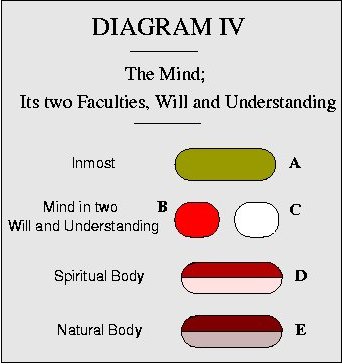| < Chapter III. The Inmost or the Soul Proper. | ^ Discrete Degrees ^ | Chapter V. Will and Understanding. - Another View. > |
 CONCERNING the "inmost" see Diagram
III. Next below the inmost stands the mind which is composed of will
and understanding B and C. They are above the spiritual body
D, or within it, - above in successive order and within in simultaneous
order.
CONCERNING the "inmost" see Diagram
III. Next below the inmost stands the mind which is composed of will
and understanding B and C. They are above the spiritual body
D, or within it, - above in successive order and within in simultaneous
order.
The will is drawn in red because it is the receptacle and abode of love or good. The understanding is drawn in white because it is the receptacle and abode of wisdom or truth. See reason for this in "Colour in the Diagrams" page 11.
Below the mind stands the spiritual body D. This body being but a derivative ultimate and foundation of the mind, or in simultaneous order its envelop and containant, has a quality like that of the mind. The mind is both voluntary and intellectual, the voluntary is drawn in red, the intellectual in white. Hence the spiritual body (their complex in ultimates) is both red and white - red from the will and its affection, white from the understanding and thought. Hence also the rosy tint and lily white in the countenance of an angel, and the fire and light in the countenance and eyes of man. (DLW 369; CL 42, 384.)
The natural body E, the last in the series, is drawn in Colour moderately red and white for the same reason, and being an effect from the prior forms may be called the mind in its extreme organism. Hence the presence in the body of dual organs and parts, as two hemispheres of the brain, pairs of nerves, two eyes, two hands, two feet:- the right an ultimate of the will, the left of the understanding.
The spiritual body in form and quality is like the mind, being beautiful and lovely, and inwardly pure and orderly if the mind be so. So too the natural body has an inward quality or nature more or less like the mind and bespeaks its state.
With the adult sufficiently advanced in years the natural body becomes in quality more or less like the mind, pure in substance, orderly in texture and moral in tone with the regenerate, and the reverse with the wicked. (DLW 135 to 143, 420, 423; AC 6872, 5559, 5726.)
Were the natural body more plastic, as before the fall, and were it under no other spiritual influences than those of its own mind and the particular spirits conjunctively associated with that mind it would exhibit far more than now the state and features of the mind. Then the inward order and purity of the body of the good would well answer to the state of the will and understanding. This inward order and purity, however, might nor be observable, yet its external form and beauty would be manifest. It would be the same with the body of the evil, but opposite from an opposite state of the spirit.
Since the fall and especially in later ages the implasticity of the body impedes its full response.
But why are not the bodies of the wicked as much defiled and deformed with natural impurity and disease as their minds, with moral and spiritual impurity? Why are their bodies often beautiful and healthful? This is from a merciful provision for the security of Divine ends, one of which is that a general influx from heaven shall largely order and control the corporeals of man that they may not be controlled by an influx from the particular spirits attendant on him. Thus whatever of health or beauty appertains to the wicked, is due to a general heavenly influx directly into the exteriors of the natural body. We say exteriors of the body meaning its gross and solid parts, because in the case of the evil the vital fluids are always more or less defiled. (DLW 423.) Even when health and beauty are an inheritance they are maintained by this heavenly influx and were mostly of such origin in the ancestors. (AC 5862, 5990, 6192, 6211)
Concerning the hereditary state of the infantile body see Diagram XVIII.
The will and understanding are organic forms. (DLW 373.) Concerning these faculties in general, consult The New Jerusalem and its Heavenly Doctrine, 28 to 33.
| Previous: Chapter III. The Inmost or the Soul Proper. | Up: Discrete Degrees | Next: Chapter V. Will and Understanding. - Another View. |